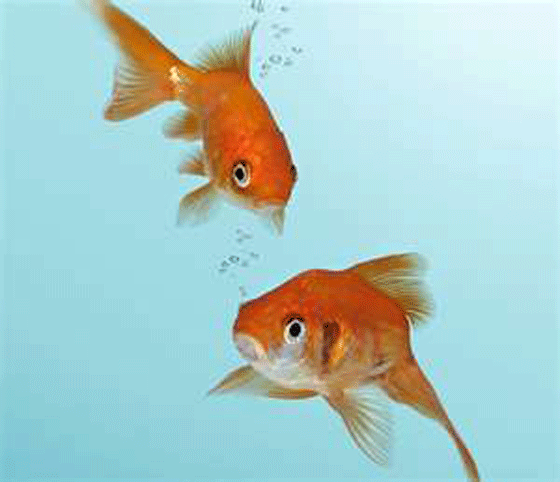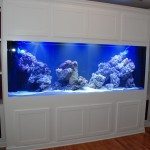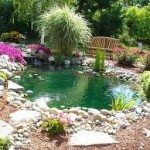This article contains affiliate links. If you make a purchase after clicking on a link I may earn a small commission at no extra cost to you.
The optimal temperature range of water for a goldfish tank is 23 to 24 degrees centigrade.
Properly treated water kept at the preferred temperature means the difference between fish that are healthy and those that are slow, lethargic, stressed and susceptible to disease.
Frequently asked questions
What kind of water do goldfish need?
Goldfish are often thought to be tropical fish, as they’re certainly not cold water fish. Is this really a true description?
Although goldfish can live in temperatures as high as 30 degrees centigrade, experts recommend keeping them in water that’s between 23 and 24 degrees. This brings them into the middle ground between being cold water fish and tropical fish.
The question then is, “Why do they thrive in a water temperature range that’s a little cooler than the average tropical fish needs?”
The answer is simple. Goldfish can become stressed in higher temperatures, and yet they draw their energy from the water. They’re powered by it.
If you were to look at a fish living in water heated to 15 degrees, and a fish living in water of 25 degrees, you’d notice huge differences. Allowing for similarities in health, age, and size there’d be advantages you could and couldn’t physically see.
What are the benefits of warmer water?
The fish would almost certainly
- be a faster swimmer
- have a better digestion
- and have a stronger immune system for warding off disease.
Why change the temperature of goldfish water?
There are times when it might be necessary to raise or lower the temperature for short periods of time, taking the temperature outside it’s optimal range.
“In what circumstances should I adjust the temperature?”
Usually there’s only 2 reasons that goldfish water should be heated or cooled.
Luckily goldfish are remarkably hardy and while they do prefer more moderate temperatures they can live quite comfortably in temperatures ranging from roughly 10 to 30 degrees celsius. (There are reports from pond owners who claim their goldfish survived a frozen pond over winter.)
Of course, they won’t thrive as they would in optimal temperatures, but if they’re kept within the acceptable range they shouldn’t suffer and will quickly adapt to their new environment.
Raising or lowering the water temperature for goldfish shouldn’t be done without good reason and solid planning.
Does water temperature affect goldfish breeding?
Yes. The reproductive abilities of a goldfish is highly influenced by the environment.
The fish follow a seasonal pattern whereby they release more androgen (a reproductive hormone) in the warmer spring temperatures, and less of the hormone in the cooler winter months. An evolutionary pattern that ensures a higher survival rate for larvae in the wild.
Fish breeders find that by mimicking the natural seasonal changes and raising goldfish water temperature slightly in the spring to around 25 or 26 degrees centigrade, and lowering the temperature to between 10 and 12 degrees in winter, that their fish breed more easily and produce healthier, hardier larvae.
Can disease be treated by changing water temperature?
Yes, to treat particular parasite infestations. There can be a need to adjust the water temperature either by heating or cooling if it’s recommended by a fish vet, or if you’ve reasonably diagnosed your fish with a specific disease that can be successfully treated through temperature changes.
Experts often recommend raising the temperature of goldfish water to around 30 degrees celsius for a roughly 10 days if the fish becomes infected with parasites. Treating White Spot by raising water temperature can be very effective.
Unfortunately the most common fish parasites tend to have rather long life spans. Between 1 and 2 months on average. While temperatures of 30 degrees aren’t enough to kill the parasites off, it’s enough to significantly reduce life expectancy of the parasite. This can speed up the healing of your goldfish making it more resilient and when used in conjunction with treatments like Malachite green, you can achieve a better outcome. It reduces stress and discomfort for your fish.
Other goldfish diseases can be treated through lowering of the goldfish water temperature. An example is the herpes virus. It’s reported that goldfish diagnosed with herpes virus living in temperatures of between 20 and 25 degrees celsius suffer a 90% mortality rate, while sick goldfish living in 15 degree temperatures have just a 10% mortality rate.
What happens to fish as temperature changes?
- Although goldfish can withstand a range of temperatures, they’re likely to suffer from stress if their environment is changed too quickly. Using a fish tank thermometer is the best way to do this accurately.
- If you notice fish are behaving oddly after a temperature adjustment, don’t panic. Your fish might swim with increased energy, or might move in uncoordinated patterns, both of which are completely normal.
Last words about changing water temperature
- If you do need to adjust the goldfish water conditions, plan to do this over a specific time frame, rather than cranking the heat up spontaneously. A good rule of thumb is to adjust the temperature by 1º per hour until your reach the temperature your’re wanting.
- There are times fish can benefit from periodic temperature changes, particularly if they get white spot or if you’re breeding fish.
- Reduce the extent of the unusual behavior by changing the temperature gradually, and you’ll see that your fish quickly returns to normal once acclimatized to the new temperature of the water.
- Aim to maintain a constant temperature within the optimal range, 23-24º c, to keep fish healthy and vibrant.
As a beginner, there are a few things to take into account, like tank size, the best food for them, and filtration. But the most important is the best water for goldfish.






